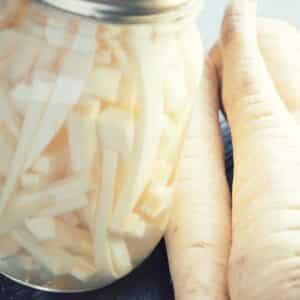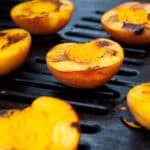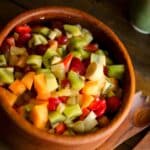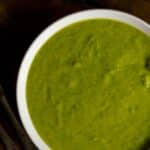From the bustling streets of Berlin to the heart of the Bavarian Alps, lacto-fermented foods have long held a pivotal place in German cuisine. One such staple, Sauerrüben, offers a delightful burst of tangy satisfaction that marries beautifully with its rich historical background and immense health benefits. For health enthusiasts and foodies alike, Sauerrüben is a glowing example of a culinary creation that's as good for the gut as it is for the soul.

Jump to:
Sauerrüben - Lacto-Fermented Turnips
Lacto-fermentation isn't just a culinary trend; it's an age-old process that dates back to the ancient Romans. ‘Lacto’ refers to lactic acid, produced by bacteria called Lactobacillus. These bacteria are responsible for the fermentation of vegetables, transforming them into probiotic powerhouses.
Turnips themselves have a storied history. Roman authors describe them as being a primary root vegetable, esteemed both for their culinary and medicinal properties. Even the Emperor Tiberius declared that the most delicate turnips should be brought to him during meals while he was in private, without his knowing that they had grown.
Fast forward to modern times, and the revival of lacto-fermented foods is a testament to their enduring appeal. In the context of Sauerrüben, this tradition-rich food is not only delicious but also a preservation method that enhances the nutrient content of turnips, making them richer in vitamins and minerals, such as Vitamin K, which supports bone health, and Vitamin C, an immune system bolster.
Take your Sauerrüben to the next level by serving it with Sheet Pan Sausages and Veggies for an easy meal, or with a Cobb Salad for an instant flavor upgrade.
Ingredients
Serves: 64 Prep Time: 30 minutes Ferment Time: 7-10 days
- 10 lb turnips, peeled and julienned
- ¼ cup sea salt
How to Make Sauerrüben - Lacto-Fermented Turnips
Place the julienned turnips little by little in your fermentation jar, pounding them vigorously and sprinkling some of the sea salt as you go along.
Make sure the mixture fills the jar up to 1 inch bellow the top (because of the expansion), adding more if needed, and that the extracted water covers the vegetables entirely. If not, create a brine of 2 tablespoons sea salt to 4 cups water and add it to the mixture.
Press the vegetables and keep them under the brine by placing a plate or a lid on top weighted down by a rock or a jug of water. Cover with a clean towel if needed to keep out fruit flies.
Place the fermentation jar in a warm spot in your kitchen and allow the turnips to ferment for 7 to 10 days.
Check on it from time to time to be sure that the brine covers the vegetables and to remove any mold that may form on the surface.
More Unique Recipes
If you love unique recipes as much as I do, then you'll want to add it to your meal plan regularly. Below are a few more family-favorite recipes to check out and bookmark for making soon.
- Braised Rabbit with Thyme
- Bacon Wrapped Sausage with Apples
- Nicoise Chicken Stew Recipe
- Paleo Bison Meatloaf
📖 Recipe

Sauerrüben - Lacto-Fermented Turnips
Equipment
- 1 Fermentation Jar
Ingredients
- 10 lb turnips peeled and julienned
- ¼ cup sea salt
Instructions
- Place the julienned turnips little by little in your fermentation jar, pounding them vigorously and sprinkling some of the sea salt as you go along.10 lb turnips, ¼ cup sea salt
- Make sure the mixture fills the jar up to 1 inch bellow the top (because of the expansion), adding more if needed, and that the extracted water covers the vegetables entirely. If not, create a brine of 2 tablespoons sea salt to 4 cups water and add it to the mixture.
- Press the vegetables and keep them under the brine by placing a plate or a lid on top weighted down by a rock or a jug of water. Cover with a clean towel if needed to keep out fruit flies.
- Place the fermentation jar in a warm spot in your kitchen and allow the turnips to ferment for 7 to 10 days.
- Check on it from time to time to be sure that the brine covers the vegetables and to remove any mold that may form on the surface.





Leave a Reply